
|
|

|
YOU ARE HERE:>>General Information>>Scarabs by Franco Magnarini, page 2
Amen-Re lord of the Palace
The pics of this piece have been sent to us by a collector who doesn't specify the material it's made of, though says it's not glazed steatite. We can only suppose, albeit with reservations, that it's a silica composition (blue frit),
This is made of 85 parts of refined sand, 15 parts of sodium carbonate (obtained from the ash of many plants) and, according to the desired colour, from 1 to 6 parts of copper oxide. The mixture, moistened with little water to obtain a paste, was shaped in a mould, then, left to dry and harden; it becomes white due to emergence of sodium carbonate. Baked at about 850° C, it become blue in colour.
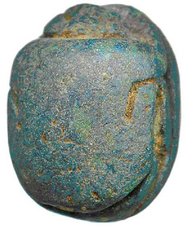
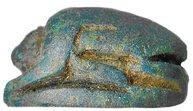
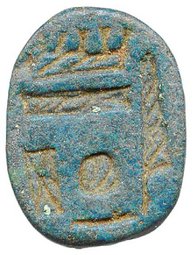
Alternatively, the material could be paste. However, it does not have the characteristic dull and "dusty" appearance of paste. It could be faience which, but lacks the brilliance which often is characteristic of faience. One might suppose that it's a vitreous paste if one could see some iridescent reflections. If it's vitreous material, which is rather rare, it would make this scarab interesting; it does not have other particular attractions in addition to its pleasant green-blue colour.
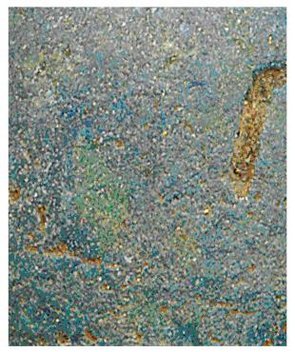
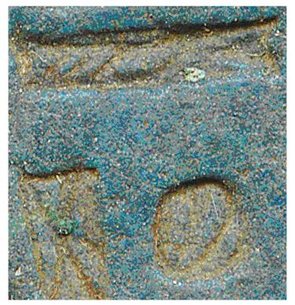
It measures 10mm x7,5mm x 5,5 mm. and has a Tufnell classification A2/O/d5 1. On its smooth back, the prothorax is suggested by two arc-shaped traces which start from sides and extend towards the rear. Legs are mid-high, thick, smooth and deeply carved.
The motif is vertically arranged and shows the signs Iê+\· which would render the writing Imn-Ra nb aH with meaning: Amon-Re, Lord of the palace. A border trace lacking.
As for the dating, we are inclined to Third Intermediate Period owing to the lack of the border trace and the diagonally hatched details inside the signs; both characteristic of this period. We are also inclined to XIX Dynasty, as a less probable alternative.
1 Tufnell O., "STUDIES ON SCARAB SEALS" vol. 2, part 1 Warminster, UK - 1984, 32-37 (we adopt this classification method because it seems to us the most appropriate to typological description, even if it has been conceived for Second Intermediate Period scarabs).
.
A UNUSUAL SCARAB OF THOTHMES III
This interesting scarab with the name of Thothmes III is decidedly unusual. It is made in light brown steatite with very vague remaining traces of green glazing.
It measures mm.19 x 15 x 8,5 and has Tufnell classification D4/vIv/d5.1
The prothorax is separated from the elytra by a T-trace. The wing-cases are bordered and marked with small V-notches, rather spaced out. The legs are high, thick, smooth and jutting out the body. Two chips on the sides of the base (that on the right wider) do not prevent a full reading. Engraving is levelled, mid-deep and well realized.
The motifs, vertically arranged in apparent disorder, shows an oval2 with the prenomen of Thothmes III, Mn-xpr-Ra, (usual writing) horizontally arranged only just under the middle.
The composition is oncluded, from top left, by the animal of Seth3 which has opposite its muzzle the sun disc followed by the tet-amulet, the so-called Isis knot (Gardiner V39, tit). It's a probable hint at the goddess Isis or a wish of wellbeing.
Below, from the left, the xa sign (Gardiner N28) = to appear in glory and a sitting lion4 simbolizing the Pharaoh.
As a whole, the composition would mean the apparition in glory of the Pharaoh, under the protection of Seth, Re and Isis.
Dated to Ramesside period (Seth do not appear on scarabs before this time, since its worship found favour beginning from Sethos I) or possibly to the Third Intermediate Period.

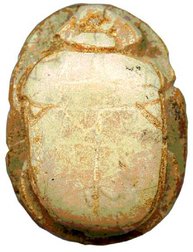
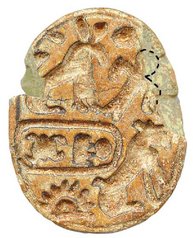
1 Tufnell O., "STUDIES ON SCARAB SEALS" vol. 2, part 1 Warminster, UK - 1984, 32-37 (we adopt this classification method because it seems to us the most appropriate to typological description, even if it has been conceived for Second Intermediate Period scarabs).
2 See Hall H.R., "CATALOGUE", London -1913, 1196, deemed ramesside, for a similar arrangement of the oval.
3 See Hall H.R., "CATALOGUE", London -1913, 1487, plaque right side, for the portraying of god Seth.
4 See Jaeger B., "ESSAI DE CLASSIFICATION ET DATATION DES SCARABEES MENKHEPERRE", Fribourg, CH - 1982, fig.81 for a similar portraying of lion.


Home | About This Site | Privacy Statement | Gallery | Testimonials | Guarantees
About Collectors' Resources pages | What's New
Search | Site Map | Contact Us